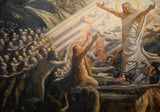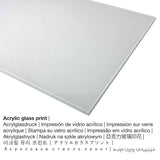Joakim Skovgaard, 1894 - Christ in the Realm of the Dead - fine art print
Tax included. Shipping calculated at checkout.
Product data
The more than 120 years old artpiece was made by the male Danish artist Joakim Skovgaard. Today, this work of art belongs to the Statens Museum for Kunst (National Gallery of Denmark)'s collection located in Copenhagen, Denmark. We are delighted to mention that this public domain artpiece is included with courtesy of National Gallery of Denmark.: . Furthermore, alignment is in landscape format with a ratio of 1.4 : 1, meaning that the length is 40% longer than the width. Joakim Skovgaard was a male painter, sculptor of Danish nationality, whose style can be attributed primarily to Realism. The European painter lived for 77 years, born in 1856 in Copenhagen, Hovedstaden, Denmark and deceased in 1933.
Choose your preferred material
We offer a range of various sizes and materials for every product. The following sizes and materials are the options we offer you for individualization:
- Canvas print: A UV printed canvas mounted on a wooden stretcher frame. A canvas has the plastic look of three-dimensionality. Canvas Prints have the advantage of being relatively low in weight. This means, it is easy and straightforward to hang up your Canvas print without the help of any wall-mounts. Canvas prints are suitable for any kind of wall.
- Printed acrylic glass with a glossy effect (with real glass coating): The print on acrylic glass, often named a plexiglass print, transforms your favorite original work of art into amazing home decoration. The artwork is custom-made thanks to the help of modern UV printing machines.
- Metal (aluminium dibond print): This is a metal print manufactured on aluminium dibond material with an outstanding effect of depth. For the Direct Aluminium Dibond print, we print the favorite artpiece on the aluminium composite surface. The bright & white sections of the work of art shine with a silky gloss but without glare. The colors of the print are luminous, fine details of the print appear very clear.
- Poster print on canvas material: The Artprinta poster print is a UV printed sheet of canvas paper with a nice texture on the surface, that resembles the original artwork. A poster print is suited for putting the art copy with a special frame. Please keep in mind, that depending on the absolute size of the poster print we add a white margin between 2-6cm around the painting in order to facilitate the framing with your custom frame.
Legal disclaimer: We try to depict our products as accurately as possible and to display them visually. Nevertheless, the tone of the printing material, as well as the printing might differ marginally from the image on your device's monitor. Depending on the screen settings and the nature of the surface, colors might not be printed 100% realistically. In view of the fact that all the art reproductions are printed and processed manually, there may as well be minor discrepancies in the size and exact position of the motif.
The product
| Product type: | art copy |
| Reproduction: | digital reproduction |
| Manufaturing technique: | UV direct printing (digital print) |
| Product Origin: | manufactured in Germany |
| Stock type: | production on demand |
| Intended product usage: | wall gallery, gallery wall |
| Orientation: | landscape format |
| Side ratio: | length : width - 1.4 : 1 |
| Implication: | the length is 40% longer than the width |
| Available material choices: | acrylic glass print (with real glass coating), canvas print, poster print (canvas paper), metal print (aluminium dibond) |
| Canvas on stretcher frame (canvas print) options: | 70x50cm - 28x20", 140x100cm - 55x39" |
| Acrylic glass print (with real glass coating): | 70x50cm - 28x20", 140x100cm - 55x39" |
| Poster print (canvas paper): | 70x50cm - 28x20" |
| Aluminium print: | 70x50cm - 28x20", 140x100cm - 55x39" |
| Frame: | not available |
Artpiece background information
| Painting title: | "Christ in the Realm of the Dead" |
| Categorization: | painting |
| Umbrella term: | modern art |
| Temporal classification: | 19th century |
| Created in the year: | 1894 |
| Artwork age: | more than 120 years |
| Museum: | Statens Museum for Kunst (National Gallery of Denmark) |
| Museum location: | Copenhagen, Denmark |
| Museum's web page: | www.smk.dk |
| License of artwork: | public domain |
| Courtesy of: | National Gallery of Denmark |
Quick overview of the artist
| Artist name: | Joakim Skovgaard |
| Alternative names: | Joakim Skovgaard, Skovgaard Joachim Frederik, Skovgaard Joakim, Joachim Frederik Skovgaard |
| Gender: | male |
| Artist nationality: | Danish |
| Jobs of the artist: | sculptor, painter |
| Country of origin: | Denmark |
| Artist category: | modern artist |
| Styles of the artist: | Realism |
| Died at the age of: | 77 years |
| Year of birth: | 1856 |
| Birthplace: | Copenhagen, Hovedstaden, Denmark |
| Died: | 1933 |
| Died in (place): | Copenhagen, Hovedstaden, Denmark |
© Copyright, www.artprinta.com (Artprinta)
Original artwork description as provided by Statens Museum for Kunst (National Gallery of Denmark) (© Copyright - Statens Museum for Kunst (National Gallery of Denmark) - www.smk.dk)
After the Crucifixion, Christ descends into the Realm of the Dead on Easter Eve to release the lost souls. With Adam and Eve at the front, the nameless dead reach out to the lightbringer who crushes the symbols of death and evil underfoot while a dark figure flees the light in the top left corner.
The literary basis for this scene was N. F. S. Grundtvig’s (1783-1872) new version (1837) of Caedmon’s Old English poem about the storming of Hell, I Kvæld blev der banket på Helvedes Port (Tonight there was a Knocking at the Gates of Hell). Skovgaard regarded his work as an artist as a calling, and his task was to let great art work as convincingly as possible for the dissemination of Christianity and the work of God.
Working out of deeply anchored personal beliefs, Skovgaard insists on depicting Christ as an almighty force that can still fight titanic battles for the sake of mankind. Mobilising the pathos and compositional dynamics of the grand style of art and combining it with his own sense of simple, decorative lines, Skovgaard not only creates an image of rare power and conviction, he also offers his personal take on how ”the grand style” could still generate relevant and interesting artistic statements.
The realm of the dead – with its anonymous throng of cadaverous beings crowding towards the light of deliverance after long years of darkness – may be Skovgaard’s allegory of his times, a period full of doubt and insecure fumbling.














